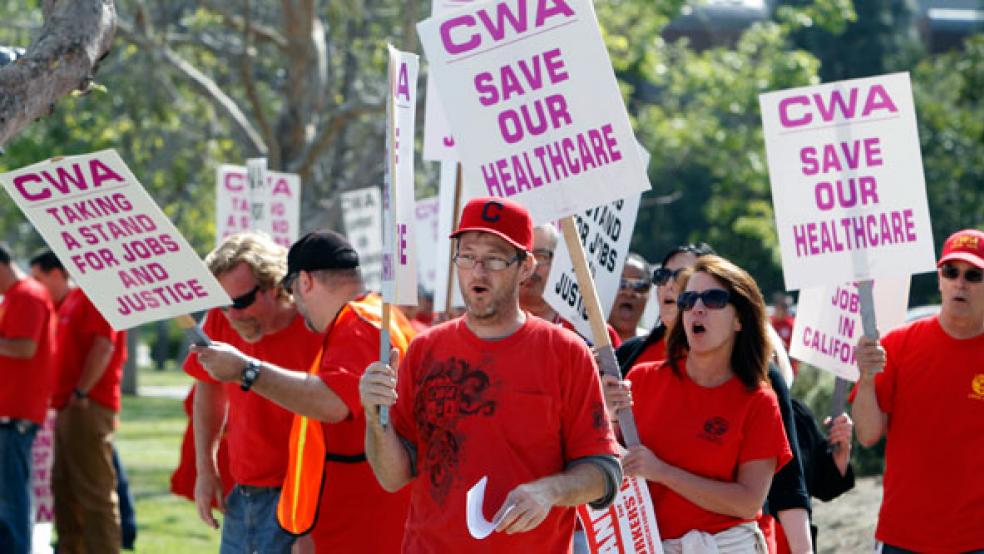Sometimes it takes a Big Bang – a startling event -- to wake up voters. The collapse of the  auto industry was just such a shocker, revealing how our high labor costs had crushed U.S. manufacturers competing on the global stage. Americans were appalled to find that General Motors was paying workers a whopping $73.26 per hour, including wages and benefits. Similarly, the flap over the so-called Cadillac tax may alert voters to the excessive benefits that have been handed out to our public employees -- benefits our cities can no longer afford.
auto industry was just such a shocker, revealing how our high labor costs had crushed U.S. manufacturers competing on the global stage. Americans were appalled to find that General Motors was paying workers a whopping $73.26 per hour, including wages and benefits. Similarly, the flap over the so-called Cadillac tax may alert voters to the excessive benefits that have been handed out to our public employees -- benefits our cities can no longer afford.
The Affordable Care Act was meant to slow the rise of healthcare costs. One of its critical weapons in that fight was the so-called Cadillac tax on high-end insurance plans. Generally, the tax will amount to 40 percent on the excess cost of plans valued above $10,200 for individuals or $27,500 for families. The tax was aimed at employers--faced with a hefty levy on benefits packages, managers were expected to pay more attention to their workers’ healthcare costs and to give employees greater responsibility for their medical expenses. That appears to be working; many companies are revising their programs to raise deductibles, put caps on spending or in other ways lower their bills.
The tax does not go into effect until 2018, but companies in many cases jumped the gun, worried about fast-rising insurance expenses. While the Cadillac tax makes a mockery of President Obama’s claim that if you like your plan you can keep it – he failed to mention that your plan was about to be eviscerated – there’s a lot to be said for demanding that healthcare consumers get some “skin in the game.”
While private sector workers are making do with their skimpier plans, city and state workers – and their union heads -- are resisting. Consequently, the tax for union workers will be paid by the employer – or, actually, you and me. In a recent article on the subject, the director of the Connecticut Conference of Municipalities told The New York Times, “In the end, it’s the taxpayer that’s going to bear that burden.” The upshot is this: public employees will not only continue to enjoy better benefits than their private sector counterparts do, the gap is likely to widen because of Obamacare.
With more and more cities facing serious budget problems, in large part because of excessive benefits programs for their union employees, the last thing voters want is to fork over even more money to keep those plans intact. In some cities, like Detroit, it is simply not possible.
RELATED: THE COST EXPLOSION OF OBAMACARE BEGINS TO HIT HOME
Municipal worker unions would like you to think that the fiscal collapse of Detroit is a one-off; it is not. Detroit did not go bankrupt because the auto industry shrank--it went bankrupt because, like many cities in the United States, politicians guaranteed union workers unaffordable pensions and healthcare benefits. Mayors were not blind to the unsustainable nature of these promises. They depended on unions for money and votes, and they were not likely to turn down extravagant labor requests. As the screws tightened on municipal budgets, it was easier to buy off unions with future rewards that with wages. Also, there was a good chance that when the bills came due, the perpetrators would be long gone.
Just as Americans woke up to the real costs of high union-driven wages at GM, the Detroit collapse should instruct taxpayers on the real costs of municipal and state employees. Detroit’s healthcare obligations to retirees amount to just under $6 billion of a total $18 billion due creditors. Its plans were underfunded to the tune of nearly $16,000 per household. These are not just abstract figures.
Because of such crippling obligations, emergency services took an hour to reach the scene of an accident, crime is out of control, and people are hurting.
RELATED: OBAMACARE GLITCH NO. 1--VERIFYING ELIGIBILITY
Detroit, however, was only the third worst in the country. Both New York and Boston owe more. Lest anyone think this is unusual, consider a Pew report out earlier this year that showed 61 of our largest cities owing $118 billion in healthcare benefits, only 6 percent of which was funded. By comparison, those cities had funded 74 percent of their pension obligations. Healthcare is crushing city budgets.
Union leaders saw this day coming, and were among those most opposed to the Cadillac tax. They knew that the tax would clobber cities like New York, which is expecting to shell out $22 million in Cadillac taxes in 2018 and an astonishing $549 million in 2022.
They also anticipated, correctly, that the levy would alert people to the above-average healthcare benefits public employees enjoy. New York City’s most popular plan for its employees costs $18,349 for family coverage; the national average is $15,745.
Why was the Cadillac tax included in the first place? To dampen the rise in healthcare costs, and because Obamacare needed money. The CBO expects the tax to rake in some $80 billion in its first five years. The ramp-up is quick – from $5 billion in 2018 to $22 billion in 2023 because of the manner in which the “trigger” level is indexed to inflation. The rise will continue.
As the arrival date of the Cadillac tax draws closer, we will hear more complaints. Some analysts estimate that the tax will eventually hit as many as 75 percent of all employer-sponsored plans. The howling will likely be loudest from those with the most to lose, your friendly public employees. Voters must demand that public unions take the same kinds of cuts to benefits that everyone else will suffer…. And elect mayors who make it happen.






